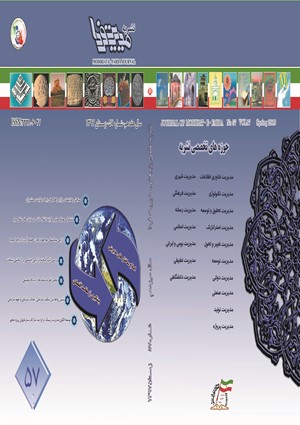طراحی مدل مفهومی ساختاری – تفسیری رهبری ناب؛ مبتنی بر رهیافت های جامع جوهره مفهوم ناب
محورهای موضوعی : مدیریت صنعتیمرجان اعتمادی 1 , میر علی سید نقوی 2 , جهانیار بامداد صوفی 3 , مهدی حمزه پور 4
1 -
2 - دانشگاه علامه طباطبایی
3 - دانشگاه علامه طباطبائی
4 - دانشگاه امام صادق علیه السلام
کلید واژه: رهیری ناب رهبری ناب مدلسازی ساختاری -تفسیری,
چکیده مقاله :
رهبری یکی از پیچیده ترین، ناشناخته ترین و یکی از مؤثرترین سازه های مفهومی در اداره سازمان های مدرن است. نقش رهبری در کارآمدی سازمان را در تفاوت های ریشه ای شیوه های رهبری سازمان ها باید دانست. رهبری ناب به عنوان مهمترین عامل در رسیدن به اهداف سازمانی در سالهای اخیر مورد توجه بسیاری از پژوهشگران قرار گرفته است. این پژوهش با هدف توسعه مبانی نظری، طراحی مدل مفهومی رهبری ناب و ارائه و تحلیل مدلی ساختاری -تفسیری از ارتباطات، قدرت نفوذ و میزان وابستگی متغیرهای شناسایی شده از مطالعات کتابخانه ای واکتساب مدل ذهنی خبرگان مرتبط با موضوع رهبری انجام شده است. به همین منظور در نهایت 8 متغیر کلیدی مرتبط با موضوع پژوهش مورد شناسایی قرار گرفت، سپس پرسشنامه ی ماتریسی ساخت یافته برای تعیین ارتباطات بینابینی این متغیرها طراحی گردید؛ نتایج حاصل از پرسشنامه مذکوربا بکارگیری رویکرد مدل سازی ساختاری -تفسیری، تحلیل و در شش سطح در یک شبکه ی تعاملی ترسیم شد. یافته های حاصل از فرآیند پژوهش نشان می دهد؛ متغیر فلسفه، اصالت و فرهنگ ناب به عنوان پرنفوذترین متغیر و متغیرهای تولید ناب و خدمات ناب وابسته ترین متغیر با کمترین قدرت نفوذ می باشند.
Leadership is one of the most complex issues, the most unknown and most effective conceptual components in the management of modern organizations. The role of leadership in the efficiency of the organization should be seen in the root differences of leadership practices. In recent years, the pure leadership has been considered by many researchers as the most important factor in achieving organizational goals. This research is aimed at developing theoretical foundations, designing a conceptual model of pure leadership and presenting and analyzing the Interpretive structural model model of communication, influence power and dependence of identified variables from library studies and applying the mental model of experts related to leadership issues. To this end, eight key variables related to the research topic were finally identified. A structural matrix questionnaire was designed to determine the interstitial relationship between these variables. The results of this questionnaire were analyzed using a Interpretive structural modeling approach and then plotted on six levels and in an interactive network. Findings from the research process showed that the variable of philosophy, authenticity and pure culture is considered as the most influential variable, and the variables of pure production and pure services are the most dependent variables with the least power of influence.
